Antique Frescoes | Graphics | Sculpture | Mosaic | Stained-glasses | Tapestry | Objets d'art | Photography | Asian Art (upcoming) | Painting
Vine and the wine in Stained Glasses

THE PARABLE OF THE VINEYARD (one of a set of 12 scenes from The Life of Christ) Jan Rombouts, ca. 1525/30, Stained Glass - The Metropolitan Museum of Art, New York
THE PARABLE OF THE WORKERS IN THE VINEYARD
Parables are used in the Bible to convey Christ’s teachings on a number of subjects. The stories are taken from everyday life to explain the ‘kingdom of God’: God’s expectations of mankind, what mankind can expect of God, and how to respect God and other people.
The expression “the eleventh hour” refers to an ancient method of calculating the time based on the twelve hours following the sunrise. The parable describes a vineyard owner who pays the same wage to all his workers, regardless of the time at which they began their work. He hires vineyard workers at dawn, then three times more over the course of the day, promising a ‘fair wage’ to his labourers. At the ‘eleventh hour’ (5pm), only one hour before the end of the working day. There he hires some more labourers, who have been waiting for work all day, and sends them to join the others. At nightfall, the employer calls together all the workers and pays them all one denier, regardless of the number of hours each man has worked. “The first as the last, the last as the first.”
STAINED GLASS IN THE MIDDLE AGES - Notre-Dame of Chartres and Notre-Dame of Paris windows
Roman art’s successor, Gothic art reigned supreme from the second half of the Middle Ages to the Renaissance – a period of around 400 years. The size of the cathedrals allowed for more art to be displayed and artists to express themselves via glasswork: walls became less imposing and windows much more so, allowing for better light. A symbol of transcendence, Medieval windows were both an exultant decorative feature and a barrier separating the cathedral from the outside world.

ARIES ZODIAC SIGN, MAN PRUNING HIS VINE Rosace ouest - Zodiac, 1220/25 - Notre-Dame de Paris / 11

LIBRA ZODIAC SIGN, TREADING OF THE GRAPES Rosace ouest - Zodiac, 1220/25 - Notre-Dame de Paris / 12

WHEELWRIGHT AND COOPER (detail of the Noah Window) The trades, north aisle - 1205/15 - Chartres Cathedral, France

CARRYING A BARREL Story of Saint Lubin, 1205/15 - Chartres Cathedral, France

WINE DRAWING FROM A BARREL Story of Saint Lubin, 1205/15 - Chartres Cathedral, France
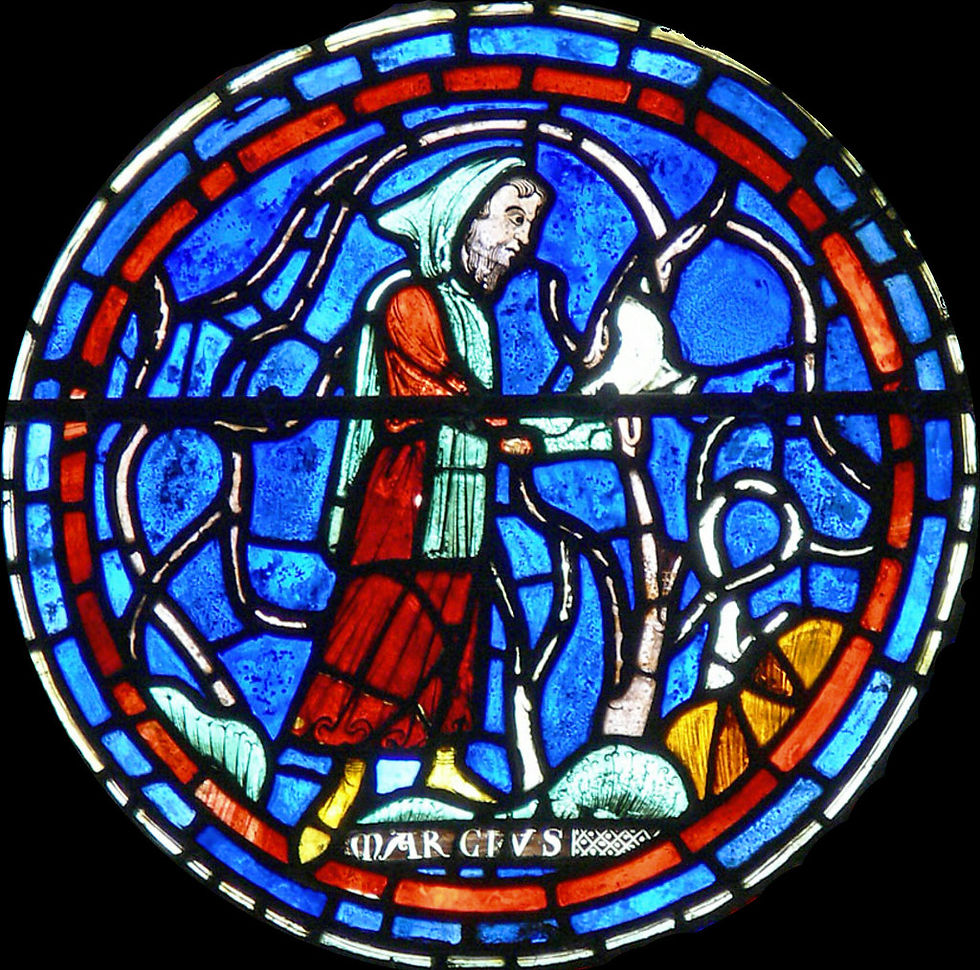
MARCH - VINE PRUNING Zodiac and Works of the Months, 1217/20 - Chartres Cathedral, France / 4
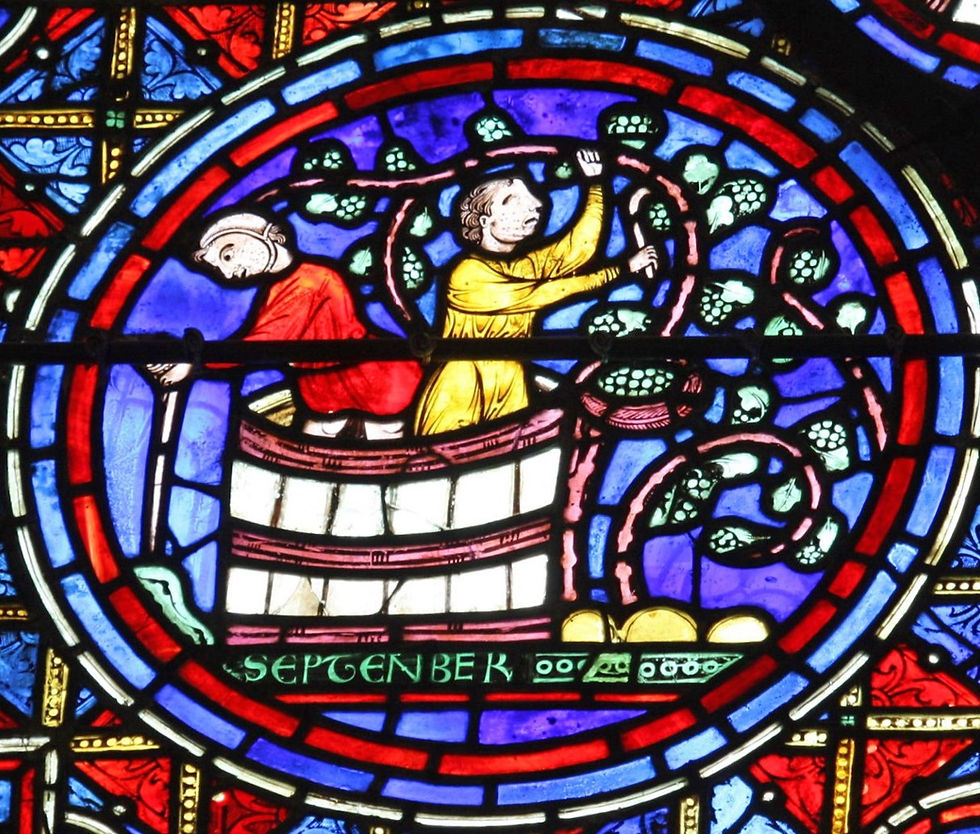
SEPTEMBER - HARVEST AND TREADING Zodiac and Works of the Months, 1217/20 - Chartres Cathedral, France
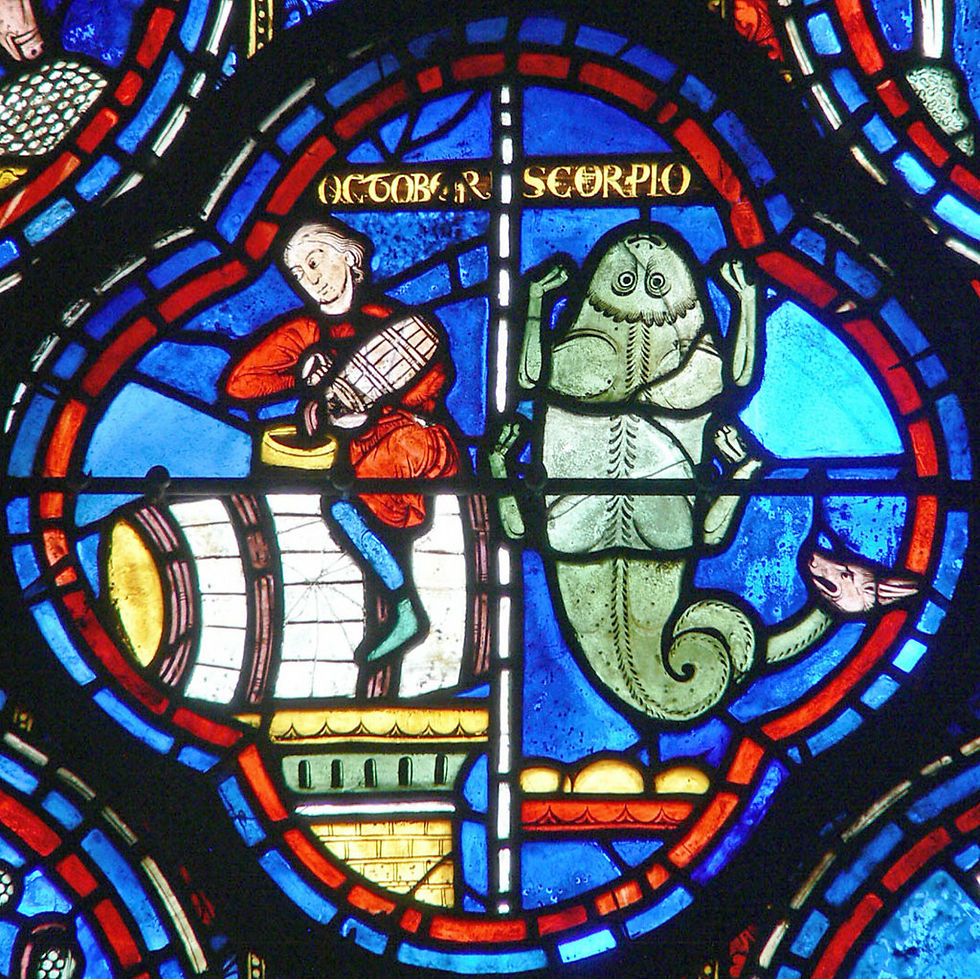
OCTOBER - TOPPING-UP Zodiac and Works of the Months, 1217/20 - Chartres Cathedral / 6
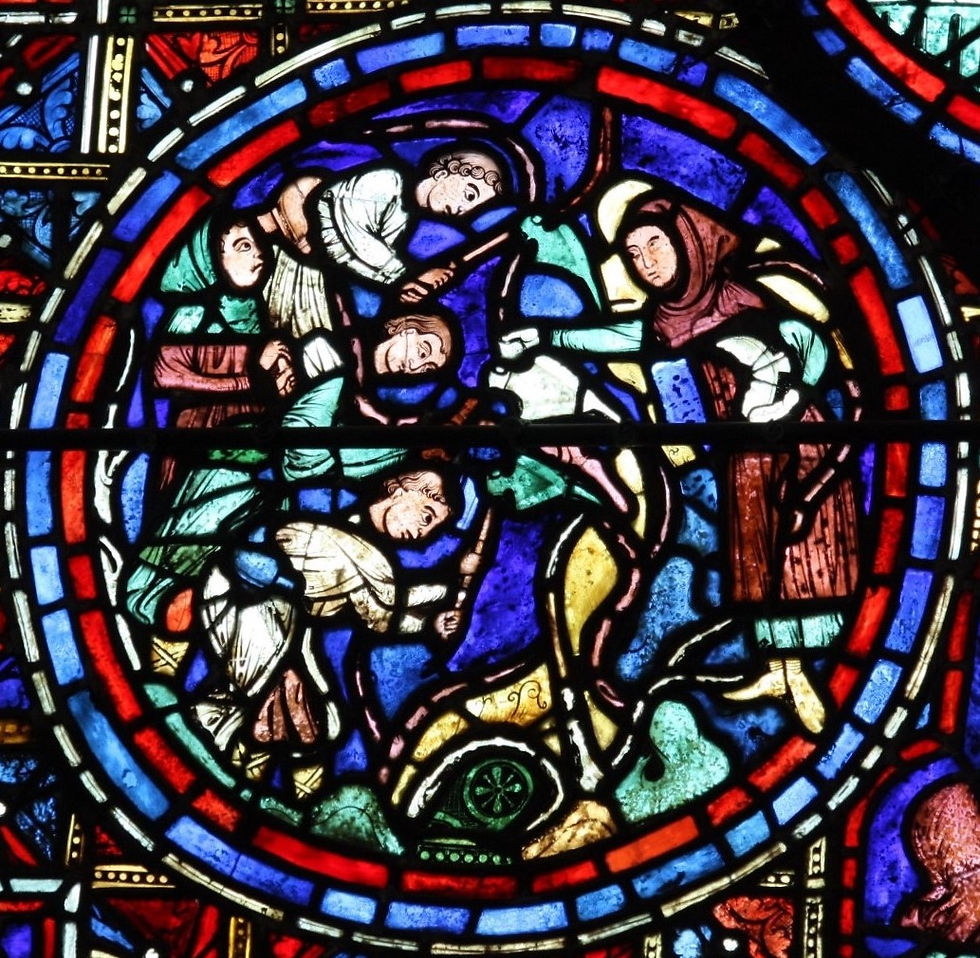
WINEGROWERS PRUNING THE VINE Zodiac and Works of the Months, 1217/20 - Chartres Cathedral, France

TWO WINEGROWERS PRUNING THE VINES Story of the Virgin, 1217/20 - Chartres Cathedral, France / 8

SAINT-VINAGE Histoire de Saint Lubin,1205-1215 - Cathédrale de Chartres / 9

DES LÉPREUX Histoire de Saint Lubin, 1205-1215 - Cathédrale de Chartres / 10



LEPERS Story of Saint Lubin, 1205/15 - Chartres Cathedral, France / 10


4. Symbolically, the pruning of the vine evokes the pruning of one’s desires: as too much sap produces an undisciplined, invasive and infertile plant, all superfluity must be cut away.
6. After the harvest and the pressing of the grapes, the wine is put in a barrel. At the start of the process, the barrel needs to be topped up regularly in order to keep it full. Here, the vineyard worker fills up the barrel with a smaller keg.
8. The vineyard workers prune the vine – an activity that traditionally takes place in March. They wear cloaks to protect themselves from the cold, and cut back the vine with a curved pruning knife. Secateurs were only invented at the start of the 19th century.
9 and 10. Ergotism, or St Anthony’s Fire, was – along with plague, leprosy and syphilis – was one of the four great maladies of the Middle Ages. Aside from the thaumaturgic approach (employing the services of a miracle-maker) and surgery (necessary when gangrene didn’t cause the limb to drop off on its own), there were treatments for St Anthony’s Fire: holy wine (a wine brought into contact with saintly relics, possibly imbued with medical substances); a similar “water” (St Anthony’s Water); fomentations (warm compresses, applied locally and externally) and ointments intended to sooth the condition’s painful burning sensations). (Source: Pierre Bachoffner, 1997). The Hôtel-Dieu of Beaune carried the name of St Anthony, patron saint of hospitals thanks to the involvement of the Order of St Anthony in caring for sufferers of the condition. Saint Vinage – wine first sprinkled on the statue of a saint – was among the medicines used. Here we are at the leper hospital of Grand Beaulieu in Chartres. The carers wore red; the patients, white. As a cure, sufferers were made to drink Saint Vinage – wine or water first poured over the case containing the cathedral’s holy relics. A monk in red holds a cup of this drink and a patient in white shows his face, holding up his “martyr’s” hands. At this time, lepers were considered martyrs, suffering as Christ had suffered and curable only by God. They were therefore favoured by Him, having been chosen. If this stained glass features a lot of lepers, it’s because St Leobinus also suffered from leprosy: he was said to have worn a false nose, his own having been lost to the disease. During this period, all skin conditions and even ergotism were considered “leprous”.
11. The Western rose window of Notre-Dame escaped the 2019 blaze. The stained glass panels depict each month’s agricultural work associated with its zodiac sign, Virtues and Vices, the prophets and, in the centre, the Virgin Mary. Traditionally, Aries – the first fire sign – starts off the new annual cycle. Spring has just arrived and a man is pruning the vine.
12. The autumn’s activity (Libra) starts with the grape harvest. This would be followed by the treading of the grapes – the start of the vinification process.
STAINED GLASS IN MODERN ERA - Conches-en-Ouche Church, St-Etienne Church in Paris, Troyes Cathedral, and the Mystical Press
The modern era, which followed on from the Middle Ages from the beginning of the 16th century, continued to nourish the savoir-faire of master glassworkers.

NOAH PLANTING WITH VINES c. 1550 - St-Peter and Saint-Paul Church, Brienne-le-Château, Aube, France

NOAH GETTING DRUNK c. 1550 - St-Peter and Saint-Paul Church, Brienne-le-Château, Aube, France

NOAH WITH HIS THREE SONS c. 1550 - St-Peter and Saint-Paul Church, Brienne-le-Château, Aube, France

BELSHAZZAR'S FEAST Grisaille, 1531 - Eglise Saint-Pantaleon Church, Troyes, Aube, France

MARRIAGE AT CANA Grisaille rehaussée d'argent 1535/45 - Eglise St Pantaleon Church, Troyes, Aube, France
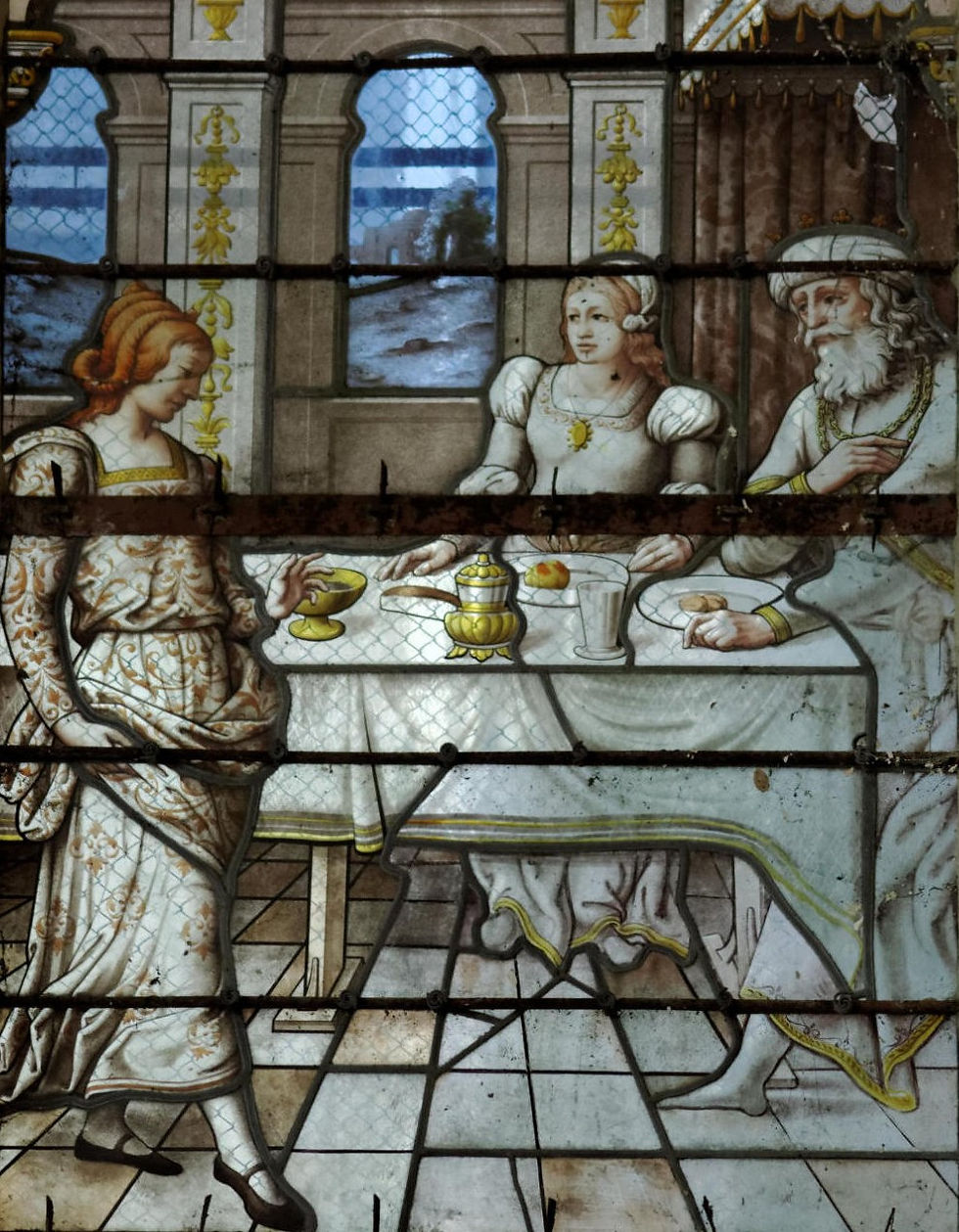
FEAST OF HERODE AND SALOME DANCING Grisaille, 1541 - Saint Georges Church, Chavanges, Aube, France

THE MYSTICAL PRESS St Foy church, 1552 - Conches-en-Ouche, Eure, France

THE MYSTICAL PRESS St Etienne du Mont church, 1st quart of the 17th century - Paris 5th

THE MYSTICAL PRESS St Peter and St Paul cathedral, 1625 - Troyes, Aube, France
CONTEMPORARY STAINED GLASS - Reims Cathedral and Champagne window

THE GRAPE OF CANAAN Vitrail de Champagne (détail), 1954 - Cathédrale de Reims

TREADING Vitrail de Champagne (détail), 1954 - Cathédrale de Reims

WINEPRESS Vitrail de Champagne (détail), 1954 - Cathédrale de Reims
In 1954, the ‘Corporation des vins de Champagne’ commissioned the master glassworker Jacques Simon to produce stained glass windows relating to the vineyards of the region, in the tradition of ‘corporation’ stained glass of the Middle Ages. This is an example of the professional patronage which made the region famous. This window illustrates the different stages of wine production (tending the vine, harvest, etc.) in relation to the connected industries of bottle- and cork-makers.
Fernand Léger

MARRIAGE AT CANA Fernand Léger, 1954 - Church of Courfaivre, Canton of Jura, Switzerland
Pour Marcel Berthold, conservateur des Monuments historiques, "se trouver au cœur d'un tel ensemble [les vitraux de l'église St Germain d'Auxerre à Courfaivre, dans le canton du Jura, en Suisse], c'est découvrir à quel point l'artiste français [Fernand Léger] s'est montré novateur et réellement révolutionnaire ... Ce qui me frappe, à chaque fois que je viens dans cette église, c'est l'effet de lumière, de luminosité que Léger a réussi à installer. Auparavant, les vitraux mangeaient plutôt la lumière, ne diffusant que des points de couleur. On n'est plus dans ces églises sombres qu'on connaissait jusque-là dans les années 1950, grâce à l'emploi généreux par Léger du verre incolore, du verre blanc, faisant ressortir les autres plages de couleurs choisies.» Cette technique, récente à l'époque, de dalles de verre teintées dans la masse, d'une épaisseur de 20 à 25 mm et serties dans du ciment, fait que le vitrail "brille de couleurs inégalées, l'épaisseur du verre employé enrichissant et avivant toutes les teintes. De plus, une grande diversité de joints est possible et permet une grande variété d'effets." (Jeanne Bueche, architecte)
Fernand Léger voulait produire un art accessible au plus grand nombre. A Courfaivre, il demanda qu'on lui propose des thèmes : "Expliquez-moi clairement ce que je dois représenter, disait-il au curé, que vos gens soient contents ; mais laissez moi libre de la façon de le représenter, que moi aussi je sois content" Et de préciser : "Je désirai seulement apporter un rythme évolutif de formes et de couleurs pour tous, croyants et incroyants, quelque chose d'utile, accepté, aussi bien par les uns que par les autres du seul fait que la joie et la lumière se déversent dans le cœur de chacun."
Alfred Manessier, Raymond Mirande

THE TRUE VINE or THE EUCHARISTIC WINE Alfred Manessier btw. 1982 and 1993 - Reformed Church, Abbeville, Somme, France

THE LAST SUPPER WITH A BLUE FISH Raymond Mirande 1988 - St Pierre Church, Bassens, Gironde, France

MARRIAGE AT CANA Raymond Mirande 1992 - St Jacques Church, Castelnau-de-Médoc, Gironde, France











